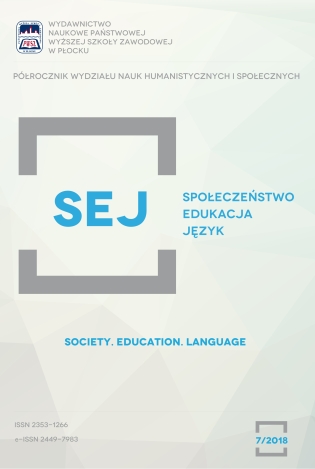On the Effectiveness of the Techniques Used to Teach the Skill of Reading to Both Dyslexic and Non-Dyslexic Elementary Learners of English
Abstrakt
DOI: 10.19251/sej/2018.7(17)
The paper discusses the usability of certain language teaching/learning techniques as applied in mixed-ability classes containing dyslexic/non-dyslexic students when practicing the skill of reading. The authors of the research aimed to find out which of the popular reading techniques may be applied in the classes containing both dyslexic and non-dyslexic students as well as how many of the techniques discussed in the research can be recognized as more useful in teaching both groups of language learners.
Keywords: dyslexia; dyslexic/non-dyslexic learners; the skill of reading; FL lessons; teaching reading; practicing techniques;
Bibliografia
References:
Annett., Marian. 1996. “Laterality and types of dyslexia”. Neuroscience & Bio-behavioral Reviews, vol. 20, 4, 631-636.
Beaton Alan. 2004. Dyslexia, Reading and the Brain. In A Sourcebook of Psychological and Biological Research, London : Psychology Press.
Baker Colin. 1997. Foundations of bilingual education and bilingualism.(2nd edition) Clevendon : Multilingual Matters;.
Bogdanowicz Marta. 1996. „Specyficzne trudności w czytaniu i pisaniu u dzieci - nowa definicja i miejsce w klasyfikacji międzynarodowej”. Psychologia Wychowawcza, 1, 13-23.
Bogdanowicz Marta, Adryjanek, Anna. 2004. Uczeń z dysleksją w szkole. Gdańsk: Wyd. Operon.
Bogdanowicz Marta. 1991. Psychologia kliniczna dziecka w wieku przedszkolnym. Warszawa: WSiP.
Bogdanowicz Marta. 2006. Specyficzne trudności w czytaniu i pisaniu – pomoc psychologiczna i pedagogiczna. In: Dysleksja rozwojowa. Perspektywa psychologiczna, ed. Grażyna Krasowicz-Kupis. Gdańsk : Wyd. Harmonia.
Borkowska Anna. 1996. „Typologie dysleksji - przegląd badań”. Psychologia Wchowawcza, 2, 116-125.
Brejnak Wojciech. Zabłocki Kazimierz Jacek. 1999. Dysleksja w teorii i praktyce. Warszawa : PTD.
Burt Cyril. 1950. The backward child. (3rd edition). London: University of London Press.
Coffey Simon, Leung Constant. 2015. Creativity in language teaching: voices from the classroom. In: Creativity n language teaching. Perspectives form research and practice. eds. Rod Jones & Jack Richards. London : Routledge.
Cook Vivian. 1991. Second language learning and language teaching. London : Edward Arnold.
Gaarder Alfred Bruce. 1977. Bilingual schooling and the survival of Spanish in the United States. Rowley, MA: Newbury House.
Hallgren Bertil. 1950. “Specific dyslexia: A clinical andgenetic. Study”. Acta Psychiat¬rica et Neurologica, 65, 1-287.
Harmer Jeremy. 2003. How to Teach English, London: Pilgrims.
Hinshelwood James. 1917. Congenital word blindness. London: Lewis.
Korendo Marta. 2009. Terapia dzieci zagrożonych dysleksją Stymulacja lewej półkuli mózgu, Kraków: Wydawnictwo Edukacyjne.
Matéjček Zdeněk. 1995. Dyslexie. Specifické poruchy učení. Jinočany: H&H.
Nickolson Rod, Fawcett. Angela. 1994) Dyslexia and Skill: Theoretical Studies. In Dyslexia Matters, ed. G. Hales. London: Wiley.
Richards Theodore, Rodgers Jack. 2001. Approaches and methods in language teaching. Cambridge : Cambridge University Press.
Spionek Halina. 1973. Zaburzenia rozwojowe uczniów a niepowodzenia szkolne. Warszawa: PWN.
Spring Carl, French Lisa. 1990. “Identifying children with specific reading disabilities from listening and reading discrepancy scores”. Journal of Learning Disabilities, 23. 53-58.
Stein John, Walsh Vincent. 1997. “To see but not to read; the magnocellular theory of dyslexia”. Trends in Neurosciences, 20. 147-152.
Stern Hans. 1983. Fundamental concepts of language teaching. Oxford: Oxford University Press.
West Thomas. 1991. In the mind’s eye. New York: Prometheus.
